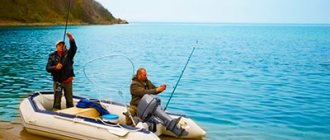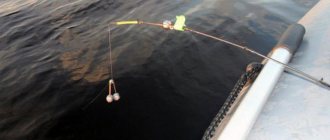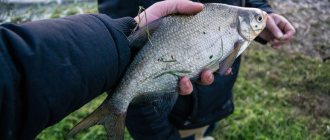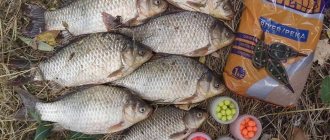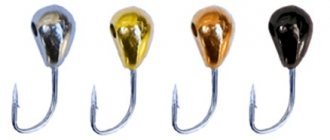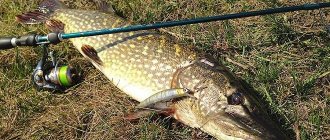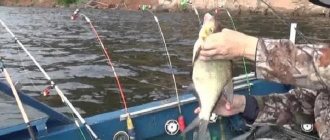We are assembling a new fishing gear - a bottle with a bite alarm for pike fishing
We screw the wine cork with self-tapping screws to the cork of a plastic bottle.
Carefully but quickly (so that it doesn’t have time to set) pour construction adhesive or cement into the bottle up to the “waist” of the bottle.
We attach the flag using electrical tape (bright colors) to the bottle above the “waist”.
Next, around the “waist” itself we wrap the tackle for catching pike with live bait on a bottle - a fishing line of 10-15 meters, a leash, a stop and a couple of swivels.
One swivel for the leash, one for the sinker at the end of the fishing line.
You will need a larger stopper so that the swivel does not fly over, so that the leash with live bait moves freely along the fishing line.
More details about installation and assembly nuances in the video:
Tackle design
For fishing from a boat
To make fishing tackle from a plastic bottle, you will need a vessel of suitable volume and a fishing line or nylon cord 8-16 m long. They are attached to the future tackle in the neck area. For greater reliability of fastening, you can make holes in the cork or neck through which the cord will be threaded: this way you will be sure that the bottle will not come undone after prolonged use.
A sinker is attached near the end of the fishing line or cord. A sinker tied to the end of the fishing line can have a mass of up to 100 g and must be sliding. In some cases, you can use more massive objects that will help hold the tackle in the installation location.
The attached cord or fishing line is folded into a knotted loop to which a metal leash is attached. It will carry a hook, the size of which can also vary depending on the size of the expected catch.
The technique of fishing with a bottle from a watercraft is simple. In order not to miss the moment of a bite, you can apply stripes of paint or other marks on the bottle, which will show its change in position. The level of the marks must be chosen taking into account the fact that when fishing, the bottle needs to be filled 2/3 with liquid so that it remains on the surface of the water with the neck down.
For shore fishing
The device for catching pike from the shore differs from the version for fishing from a boat in that the cord is attached to the bottle not only in the neck area: you need to wind another 5-8 m at the narrowing point of the container for a more reliable fixation. Using a cord, the tackle will be connected to the shore.
A sinker is attached to the end of the cord, which can be made motionless. A steel leash is attached 0.5 m above it.
The moment of the bite is determined by the movement of the bottle on the surface of the reservoir. It is not necessary to monitor the bottle; it can be attached to the nearest strong branch at night. The gear is checked in the morning for the presence of a catch.
For successful fishing from the shore, you need to choose the correct casting distance and evaluate how well the bottle is secured. Before casting the equipment, unwind the cord, lay it in rings so that it does not get tangled. Secure the end to a branch or other reliable object. Check that all accessories are securely attached to the bottle. Fill it 2/3 full with water. Attach the live bait and start fishing.
Homemade summer zherlitsa from a plastic bottle
Today in this article I just want to tell you about how you can speed up and increase the number of fish caught. I want to share with you the “recipe” for making a zherlitsa.
A zherlitsa is a fishing tackle adapted for catching predatory fish, such as, for example, pike, perch, catfish and others... As you know, predatory fish like to feed on their own kind, that is, fish, so you need to fish in this way with live bait. There is a variety of zherlitsa: both summer and winter zherlitsa.
In this article I will tell you about the summer zherlitsa.
I will begin my story about making this fishing tackle by explaining what things we will need.
So, for our craft we will need: - a small stick (it can be either wooden or made of any other dense material). I used a metal-plastic inch pipe; - scotch; - scissors or knife; - lace or small rope; - plastic bottle; - a piece of fabric.
So, let's start making...
To begin, take a plastic bottle (I took a 1 liter bottle) and cut off the neck of the bottle...
Now I’ll tell you how it all works... So, you come fishing, fix this shelf with one end into the bottom of the reservoir, and the other end sticks out, then the predator swallows your bait in the form of a live fish and pulls it along without feeling any resistance... Into this time the line unwinds and the plastic bag also unwinds (this is a signal to the fisherman that a predator has been caught), and the predator continues to pull the fish... As soon as the line finishes unwinding, it rests and thereby automatically hooks the predator, which has already completely swallowed your bait... Next, the fisherman pulls fishing line and pulls out the trophy! That's all!
For fishing by boat
Rigging a bottle is similar to fishing with mugs, however, given the nature of the rig, you need to make some adjustments to the assembly in order for fishing to be effective.
- For this, a plastic bottle with a capacity of 1 to 2 liters can be used, it is important that it is not damaged, then you need to attach a piece of fishing line, the length of which should be from 8 to 16 meters, to the cork. A sliding sinker must be installed on the fishing line; its weight should be around 100 grams.
- However, it is worth paying attention to the fact that 100 grams of sinker is an average value. It is necessary to select a specific value based on the weight and size of the predator that you plan to catch in this way.
- Next, at the end of the base, you need to start creating a knot-type loop, this is necessary in order to install the leash on the device. You need to pay attention that when fishing for pike, the leash must be metal. In other cases, fluorocarbonate can be used.
The hook also needs to be selected based on the weight of the future fish caught. If you plan to catch pike, you can install double and triple hooks, this will be enough.
For carp, or for example perch, a single type hook will be sufficient. There are several ways to install a bite beacon. Most fishermen use a spring and a flag.
Thus, when the fish bites and the line begins to unwind, the flag will straighten out above the surface of the water and notify the fisherman about the bite.
Bottle installation
The bottle, which plays the role of gear for catching pike, has an extremely simple design. Its device is simple and does not have intricate components, so installing it independently does not cause any particular difficulties for users.
You just need to take into account that such gear will be divided into 2 different types based on the following indicators:
The principle of operation of both copies will be the same, but there are still certain features in the installation of different gear. The equipment will be assembled from five important components.
Let's look at how to make a similar tackle for catching pike with your own hands.
What does a circle represent?
A circle is a small fishing tackle, used mainly for pike. According to the law, you can use five pieces; more is poaching.
Fishing with mugs is welcome on a reservoir with at least some current
It looks like a circle with a small mast in the center, painted red and white. You can buy it in the store, but it’s not difficult to make it yourself.
Factory-made tackle is almost never in demand. It is made entirely of hollow plastic, the pin can be either removable or connected to a circle. It is considered a replacement for a regular mug, but experienced fishermen prefer self-made things.
This thing is also called a floating vent. It does not depend on the fisherman and moves through the water independently. Live bait is used as bait.
The main advantage of the circle is that it allows you to fish where other gear would be useless, that is:
- Far from the coast.
- In the reeds and reeds.
- Over snags and driftwood.
- In the rubble.
The device does not require control by the fisherman, and it often happens that it swims to the right places on its own.
Equipment
Equipment for effective catching of toothy predators will consist of the following positions:
The weight of the sinker should be chosen in such a way that the plastic tank is slightly submerged and held vertically, but at the same time does not sink. It can be placed on the main line just above the leash with a hook. In this situation, the live bait will be able to freely move the plastic vessel around the reservoir.
There is a second option - hunting with stationary gear. In the above case, a sinker attached to the end of the fishing line is lowered to the bottom of the reservoir, and a leash with a hook is fixed above it. This type of component, which can be equipped with the elements used, will be ideal for fishing on rivers - here it does not risk being constantly carried away by the current.
The method described above can be used when catching toothy predators is carried out near grass edges and in windows among dense thickets. In this situation, the chosen baitfish or wind gusts can send the plastic container into overgrown areas, and there it risks becoming tangled.
Selection and attachment of bait
As an attractive bait for catching pike, you can use other small fish that live in the reservoir in which you plan to hunt for a toothy trophy. Mainly used for this are:
The dimensions of the live bait are chosen based on the dimensions of the future trophies caught. If you plan to catch a pike that is not very large in size, then you can use fish with a length of 5 to 10 cm. But where large-sized predators mainly live, it makes sense to hunt for it more concentratedly, using live bait with a length of 15 cm.
Fishing technique
In most situations, pike are caught using a bottle from a boat and much less often from the shore. Fishing for toothy predators from a swimming device can be done in two ways: active or passive. If the hunt is active, then, after completing the installation of gear, the angler should remain in the immediate vicinity to wait for bites. As soon as the pike grabs the bait, it will reel in the fishing line.
In this case, the weight will fall to the bottom of the reservoir, and the bottle will lie on the water surface.
As soon as the fisherman notices this, he will definitely need to get close to the reacting gear in a boat. After this, you will need to make a hook, and then start fishing for the caught trophy. If the pike behaves quite actively, then it can rush violently from one side to the other in the water.
When a pike is overly active, catching it with a bottle is not so easy. To pull out a toothy predator, the angler will need some skill, since in this situation help will not come from either a rod or a reel with a friction brake.
If the angler resorts to the passive method of catching pike, then it will be enough to place the bottles in the water area selected for hunting. After this, they will need to be checked in a few hours. At this moment, the fisherman will need to get pike, which during this time managed to swallow live bait and ended up on the hook. Events of this type require a minimum amount of free time and effort.
However, you definitely need to prepare for the fact that many of the predators in question, which are nevertheless attracted by the bait, will not be detected or will be able to jump off the hook before the fishermen arrive.
